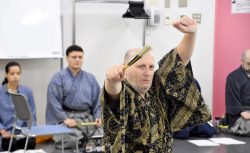
Noh play “Hagoromo” is staged during the inaugural meeting of the parliamentary association for the promotion of nohgaku.
16:46 JST, December 22, 2020
On Dec. 2, I went to report on an event at a venue that was not very familiar to me, a member of The Yomiuri Shimbun’s cultural news department. It was the headquarters of the Liberal Democratic Party in Nagatacho, the area of Tokyo known as the political center of Japan.
Some Diet members belonging to the LDP and its ruling coalition partner Komeito had formed a parliamentary association for promoting nohgaku theater, which includes both noh and kyogen. They held their first general meeting in the auditorium on the eighth floor of the LDP building.
A parliamentary association is a group voluntarily formed by Diet members. There are various types of such associations, many of which are launched to solve political problems, such as the one formed by Diet members working on activities aimed at the release of Japanese people abducted by North Korea. There are also quite a few parliamentary associations for cultural purposes or promoting friendship, such as the one for promoting kimono, whose members wear kimono to the Diet on the New Year’s Day.
In the fields of traditional performing arts, LDP members launched a parliamentary association on kabuki in 2014 and on rakugo comic storytelling in 2018. Former Prime Minister Junichiro Koizumi, now retired as a Diet member, is known as a big kabuki aficionado, while his son, Environment Minister Shinjiro Koizumi, is a rakugo fan who frequents yose theaters for rakugo. He is a member of the parliamentary association for rakugo.
Noh and kyogen are representatives of Japanese performing arts whose history stretches back about 700 years. Nohgaku theater became the first traditional Japanese performing art to be designated as an intangible cultural heritage of humanity by UNESCO in 2001. In the early days in the history of nohgaku, it became popular among samurai lords as a pastime befitting their high status. Warlord Toyotomi Hideyoshi in particular was very fond of noh and performed the art himself on stage.
“To warlords during the warring states period in the 15th and 16th centuries, watching noh was a precious time to reflect on themselves,” said one noh master whom I interviewed in the past. Come to think of it, it might be fitting for a Diet member to become fond of noh, considering that the person represents a constituency, in other words, a domain, like a warlord presiding over a castle centuries ago.
I looked at the list of the association’s promoters, and it seems many of them are past education ministers. The list also includes a House of Representatives member who is a former leader of the Komeito party.
At the meeting that day, an official in charge at the Cultural Affairs Agency gave a lecture on various informational and promotional measures for nohgaku. The official said there are currently 11 nohgaku performers who are living national treasures and the government offers each of them ¥2 million annually to subsidize the training of their artistic heirs.
The lecture was followed by stage performances at the LDP hall. Kyogen actor Okura Yataro and others played “Sanbaso: Momi no Dan,” a scene from the famous kyogen play “Sanbaso.” Then a cast including Takeda Munekazu, a lead role specialist, performed an excerpt from the famous noh play “Hagoromo.” The star-studded cast extended to onstage singers and instrumentalists accompanying the actors. Jiutai singers included Kanze Tetsunojo, the chairman of the Nohgaku Performers’ Association, and the kotsuzumi small shoulder drum player among the hayashikata instrumentalists was Okura Genjiro, a living national treasure.
The event was attended only by ruling coalition members. But I know that one independent Diet member regularly and avidly takes utai chanting lessons under a noh actor specializing in side roles. There is no need for a confrontation between different political positions when it comes to the promotion of traditional Japanese performing arts. I hope the association will invite independent and opposition parties members and use their combined power to develop nohgaku in a way visible to more people.
Honestly speaking, it is still difficult to see whether politics has done anything for kabuki and rakugo to make them any better.
— Morishige covers traditional performing arts.
"Culture" POPULAR ARTICLE
-

Van Cleef & Arpels Dazzles with Art Deco Artisanry at Tokyo Exhibit
-

Disney’s ‘Twisted-Wonderland’ Animated Series Puts Villains in Spotlight: New Show Features School Inspired by Classic Disney Films
-

Japan Plans to Distribute Manga Overseas Via New Platform
-

Ayumi Hamasaki’s Shanghai Concert Canceled Day Before Schedule as Part of Beijing Backlash
-

‘The World Masterpiece Theater Series’ Celebrates 50 Years; Animator Looks Back on Creating Anime Classics
JN ACCESS RANKING
-

Keidanren Chairman Yoshinobu Tsutsui Visits Kashiwazaki-Kariwa Nuclear Power Plant; Inspects New Emergency Safety System
-

Imports of Rare Earths from China Facing Delays, May Be Caused by Deterioration of Japan-China Relations
-

University of Tokyo Professor Discusses Japanese Economic Security in Interview Ahead of Forum
-

Japan Pulls out of Vietnam Nuclear Project, Complicating Hanoi’s Power Plans
-

Govt Aims to Expand NISA Program Lineup, Abolish Age Restriction























